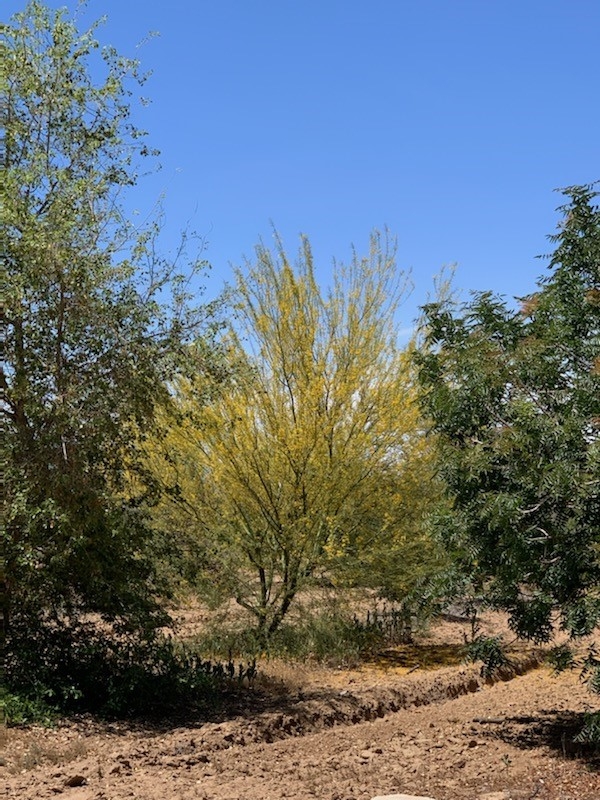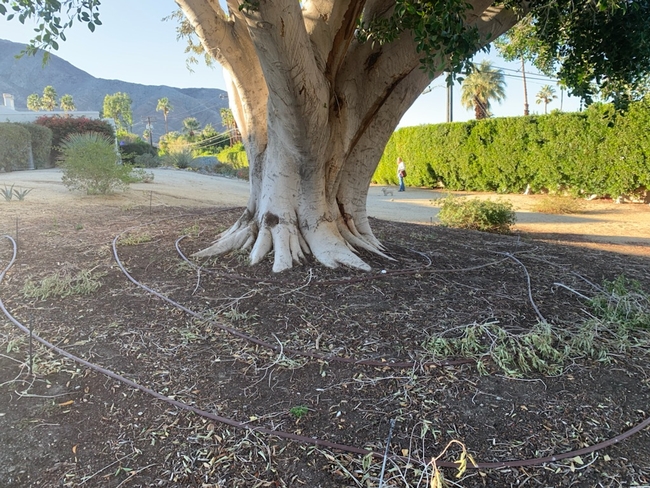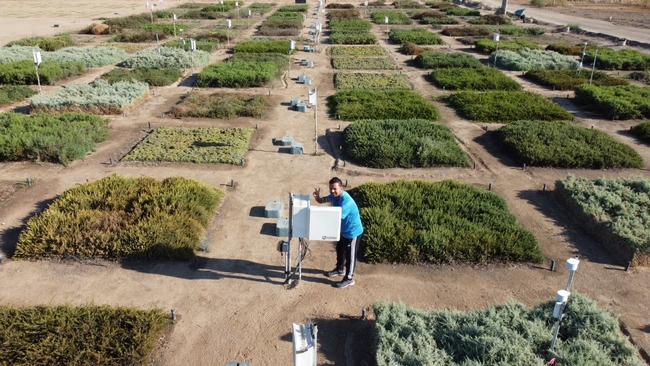Posts Tagged: shade
Save trees first: Tips to keep them alive during drought
Trees essential to lowering temperatures, cooling ‘heat islands'
Water restrictions prompted by the drought are driving Californians to prioritize how they will use their limited water. Because landscape irrigation is a major water use for many households, residents are looking outdoors to conserve water.
When choosing which landscape plants to save, “trees come first,” said Janet Hartin, UC Cooperative Extension area environmental horticulture advisor for San Bernardino, Los Angeles and Riverside counties. “Healthy communities need trees. Fortunately new California water restrictions allow for provisions to ensure trees receive adequate water to stay alive and healthy.”
“Mature trees are instrumental in cooling urban heat islands and we can't afford to lose them and start all over,” Hartin said. “Shade from mature trees can reduce surface temperatures by as much as 65 degrees in asphalt-covered parking lots. Shade from a single tree can reduce these surface temperatures from 165 to less than 100 degrees when air temperatures reach 110 degrees. Even with air temperatures in the 90s, surface temperatures can reach 140 degrees.”
In addition to providing shade, trees absorb and store carbon dioxide, release oxygen, enhance pollinators and wildlife habitat, filter pollutants from air and water and can reduce energy use, according to Hartin. Because trees take years to grow, they aren't as easily replaced as other plants.
As residents let lawns go brown, she recommends watering trees that are near or surrounded by lawn.
“If a tree is in the middle of a lawn, it is almost certainly watered by lawn irrigation,” Hartin said. “If it's not on a separate drip system, drag out a hose and allow the water to slowly trickle into the soil early in the morning or in the evening. Deep watering for two hours once every couple of weeks will keep most established trees alive."
In most jurisdictions, watering restrictions do not apply to hand watering and hand-held watering devices such as hoses, which may be used for longer periods of time than the restrictions permit otherwise. However, watering may be restricted in all cases to prescribed times of day.
“Check to see if your jurisdiction also requires a hose shutoff valve,” Hartin said.
“For fruit trees, we may have to forgo fruit production for a year or so. There may not be enough water to support fruit production, but the goal is to keep the trees alive during the drought,” she said.
She recommends watering trees away from the trunk, halfway between the trunk and the dripline – where the foliage ends and rain drips off the leaves – because “roots grow outward quite a distance as well as downward. Leave the hose on so the water is just trickling out,” she said. “You want water to seep into the soil and encourage the roots to grow deeper. The slow water flow will seep down a foot or so and the roots will follow, which will help anchor the tree. Move the hose around every half hour to hour in quadrants around the tree for more even watering.”
Don't have time to move the hose? Hartin suggests getting a soaker hose and wrapping it in concentric circles 2 to 3 feet apart.
“Soaker hoses are made from recycled tire rubber and allow water to slowly ooze out of the pores along the hose, distributing the water fairly evenly throughout the hose length. Avoid using soaker hoses longer than 75 feet due to pressure issues.”
To reduce evaporation around the tree, spreading mulch a few inches from trunk can help.
“Dark mulches can heat the environment so it's best not to use them,”Hartin said. “If you are in a fire-prone area, don't use organic wood-based mulches because they are flammable. Use decomposed gravel or pebbles, rock-based products instead. To keep sunlight out and discourage weeds, large wood chip mulches should be maintained 3-4-inches deep and smaller inorganic mulches at 1-2 inches.”
Residents may want to maintain some grass for children and pets because bare feet and paws can sustain serious burns on surfaces hotter than 120 degrees.
“People don't realize how hot fake grass can get,” Hartin said. “Research I conducted last summer in the Coachella Valley and Redlands found that surface temperatures of synthetic lawns can be more than 65 degrees higher than living turf and groundcover surfaces on several dates in between May and August.”
For California lawns, there are drought-tolerant grasses that can thrive on 30% less water than bluegrass and other cool season varieties. Examples are buffalograss and bermudagrass. They still require maintenance, such as mowing, but are great for play and recreational surfaces for people and pets.
Jim Baird, UC Cooperative Extension turf specialist based at UC Riverside, said, “Turfgrasses offer numerous recreational, aesthetic, and environmental benefits including player safety, property value, mental health, erosion control, groundwater recharge and surface water quality, organic chemical decomposition, carbon sequestration and environmental cooling.”
There are also non-turf groundcovers that are drought resistant.
“As they transpire, plants cool the environment. We have more and more drought-resistant alternatives to high-water-requiring plants on the market now, and that's where we should be going,” Hartin said.
For people considering replacing their lawns and adding new landscape plants, she recommends planting low-water using groundcovers in the fall.
“It's too hot to plant in summer and even native and drought-resistant plants require water several times week until they get established,” she said.
Most counties have a UC Master Gardener Program with a helpline staffed by well-trained volunteers dispensing advice to help keep plants alive and recommend plants that are well-suited for the local environment. Find a local UC Master Gardener Program at https://mg.ucanr.edu/FindUs.
University of California Cooperative Extension
Drought and Landscape Tree Care Resources
Keeping Plants Alive Under Drought and Water Restrictions (English)
https://anrcatalog.ucanr.edu/pdf/8553.pdf
Mantener las plantas del exterior vivas con poca agua (Spanish)
https://anrcatalog.ucanr.edu/pdf/8628.pdf
Prioritizing Trees Under Drought and Water Restrictions (5-minute video)
https://www.youtube.com/watch?v=CTKLlJgdLVk
Tips to Keep Your Landscape Trees Alive During Drought
Landscape Tree Irrigation to Maximize Tree Health, Benefits, and Beauty
Landscape Tree Irrigation 101
Top 10 Ways to Conserve Water in Your Landscape and Garden
Use of Graywater in Urban Landscapes in California
https://anrcatalog.ucanr.edu/Details.aspx?itemNo=8536
Throw a Little Shade on Me, Please
Are you tired of the triple-digit temperatures? Wish someone would throw a breeze your way and provide a little shade? A honey bee...
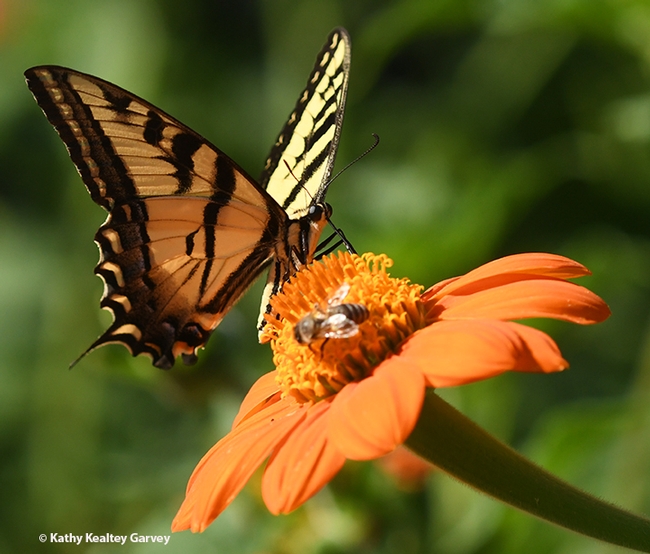
A honey bee and a butterfly, a Western tiger swallowtail sharing some nectar on a Mexican sunflower in a Vacaville pollinator garden. (Photo by Kathy Keatley Garvey)
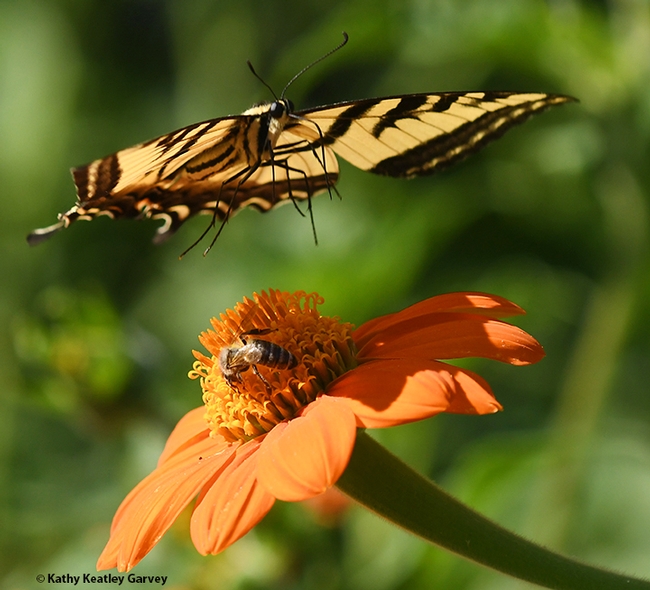
"This flower isn't big enough for both of us!" The Western tiger swallowtail lifts off, providing an umbrella—a little shade—on a triple-digit temperature day. (Photo by Kathy Keatley Garvey)
A Gardening I Will Go-I Think?
According to all the garden catalogs that come my way, it’s time to “replant, repot, rejunenate “the front yard. According to those same catalogs, it will cost merely a gazillion dollars for the plants, bulbs, corms, and tubers to accomplish this transformation; and don’t forget about the soil amendments, and fertilizers the folks also want to sell you. Yeah right, I have that kind of money to use as walking round cash! Don’t you?
This year, the front yard lost all the glorious shade that came from the late, great green ash tree that stood for 20 plus years. It’s been interesting to watch the various shrubs and bushes getting acclimated to more sun, less shade. The oleanders made the transition beautifully, but of course, have you ever seen an oleander suffer from the sun? They are now rather happy campers in the hot afternoon sun, bowing gracefully in the Suisun City gale that passes for gentle winds.
The buddleia in the ground near the front door went from full leaf to rather skimpy foliage, but made a roaring comeback – full of blossoms and hummingbirds. The buddleia in the pot, however, is still trying to find a way back from “roasted”, but is managing to hold on until cooler weather when it goes into the ground itself by the side yard gate. It gets water and encouraging words for the efforts!
The other succulents in their cozy pots that are placed around are thriving and growing like weeds, which is why some of their offspring will be at the plant exchange next weekend thanks to new Master Gardener Elizabeth! The new Heucheras that were on the front porch in the shade have taken their temporary places in pots at the edge of the early afternoon semi-shade and the afternoon pure sun. They got set there to find out just how well that spot would suit them. Hurray! They are doing very nicely and I think that area will be their “forever” home.
The only plant that is not really happy with the loss of tree shade is my 17 year-old “star” magnolia which is really missing the shade and the wind break the old tree provided. However, when the new “black tulip” magnolia gets larger than the twig it is, I hope it will provide some relief for its cousin.
There are so many plants I would like to get and put out there, but we are still living with the wreckage from the old tree. Concrete walkway parts are tilted and the driveway badly cracked thanks to the invasive roots of that ash tree; that, along with a (? maybe more?) break in the main lawn irrigation are subjects for many grousings and speculation and just plain hard work. I’ve put it all off till later, but yes, I will do it.
Right now, the “new plant” budget is just big enough for some Dutch Iris (both yellow hybrid and deep blue hybrid) and 8 varieties of Muscari or Grape Hyacinths. Originally planted around the ash tree, the bulbs there “took the hit” when the ash stump was ground out. For over 35 years, wherever I have lived, there have been Dutch iris and Muscari planted around the front yard. The only difference between back then and now are the roots left by darn ash tree that have to be hacked at, ripped out, and planted around. But it will be done! (Right, Bruce? Bruce, can you hear me?)
See you on the 12th at the Master Gardener office for the plant exchange. I KNOW that there is a plant or plants with your name on them for you to take home and enjoy!
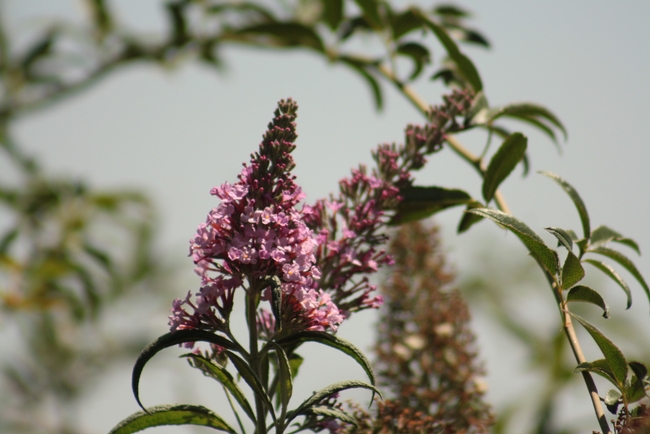
'Pink Charming' butterfly bush. (photo by Jennifer Baumbach)
On the Vallejo Garden Tour
Were you one of the smart gardeners who signed up to work with Ken Williams on the Vallejo Garden Tour? You weren’t – you didn’t? Boy, did you miss a great time touring through the selected gardens!
Lanie (newbie) and I (oldbe) were assigned a garden on Fern Place. Since this short street is right off Tennessee St near downtown, I figured that my directions were wrong; surely I didn’t err in following MapQuest! Nope, I correctly read the map, but what a difference 1 block off a main drag can make!
As I slowly went down the street, “casing the joint” so to speak, I began to forget the traffic noises and began to relax, enjoying the landscaping as I passed? Is this the place? NO!! Can this be the one?? NO!! Finally toward the street end, I saw the banana tree (Ensete ventricsum) with its deep red leafstalk and red-tinged leaves. I was there! Getting out of the car, I could barely wait to see what else was growing here!
Oh no, nobody answered the door! Was it the right day and wrong time or the wrong day and the right time? I squared my shoulders and walked down the driveway past the roses, past the gladiolas, and closer to the garage. There were pots of cacti, succulents, and other goodies that confirmed that no car ever went this-away!
There was my host, Mario, and his “helper” watering and weeding in honor of our visit. Apparently he figured that we would criticize if it weren’t “perfect”! With all the grassy weeds in my yard, I don’t point fingers at any one!
What a yard! The most gorgous exotic shade garden I have ever seen! There were pots (big ones) full of cannas; those wonderful striped leaf ones (the ‘Tiger’ series); ferns galore in even larger pots; Brugmasia, both in pots and in the ground; an enormous Philodendron bipinnatifidum with the deeply cut leaves at least 3 feet long and as wide at the stem!
All of this was growing in the shade of an Acacia tree, which was very well behaved – no suckering from the roots. Three water features, one with small koi swimming around in the basin, kept the noise from the side houses and the rear neighbor at bay.
I couldn’t understand why visitors kept mentioning how warm it was; my feet thawed out around 1pm! Looking from the shelter of the tree, I noticed just how sunny both neighbors’ yards were; I was comfy!
Leaving through the garden gate with its arch of grape vines (in barrels), the visitor was then amongst Mario’s collection of sun plants, including a Bougainvillea ‘Barbara Karst’, and then back down the driveway past the roses and to the street.
Having a river rock ground cover with both many large stepping stones and small intimate seating areas made the garden seem very large; of course, the large mirror pieces reflecting key pieces of garden statues and featured plants helped also!
Except for the large tree, this is a young garden! Mario and his life-partner, Calvin, told us that there was nothing in that back yard seven years ago when they moved in! All the work and all the planning was done by the two fellows with help from their large circle of friends! As I told them: “ya done good!”
PS: Mario asked me for a possible plant list to add to the already exotic look! I ended up trading him 2 Cymbidiums for 2 small Canna rhizomes! He thinks he got the better side of the trade. Boy, he doesn’t know!
On June 1, the entire group of volunteers goes on a “field trip” on all the gardens on the tour! I can’t wait!
PPS: Thanks to Ken Williams who coordinated this tour!
Diverse Terrariums
Ah terrariums! How I love this tiny little worlds. In my experience, which is somewhat limited, the easiest ones are the dry cactus types. So little water involved. Just add some rocks, sand, and you have an itty bitty desert in that cognac snifter you never use. Stick with shade succulents like gasterias and haworthias. Don't put them too close to a window as the glass from the terrarium will magnify the suns rays and cook them, unless you're going for the desert apocalypse look.
Another cutie is the moss habitat. These kind remind me of my sister-in-law's back yard in Washington state. Very wet, just a clearing in a forest with some fallen logs. Mosses and mushrooms and tiny flowers everywhere. Very Jurassic. So, I got brave, and made one. Mine contains babies tears, Irish moss, scotch moss, an African violet, which is normally also an outside ground cover for shade, some tilandsias, and some dinosaurs figurines for effect. Also a maiden hair fern, that is ailing, but in my defense, it's not me, it's my kitten, Vespa. She's been getting in there and piddling on it. That can't be good.
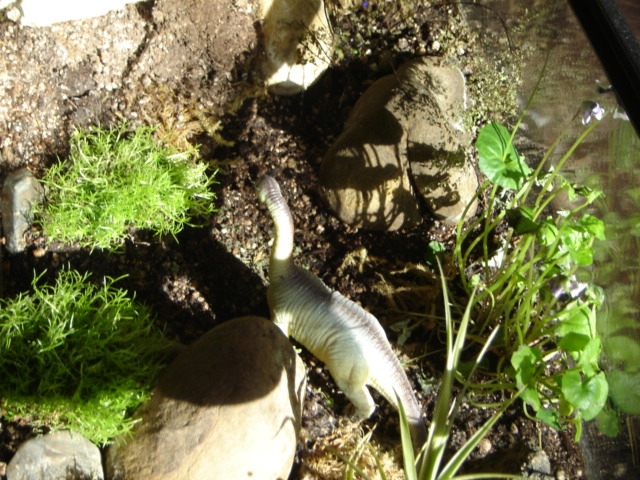
Terrarium (photo by Georgia Luiz)


